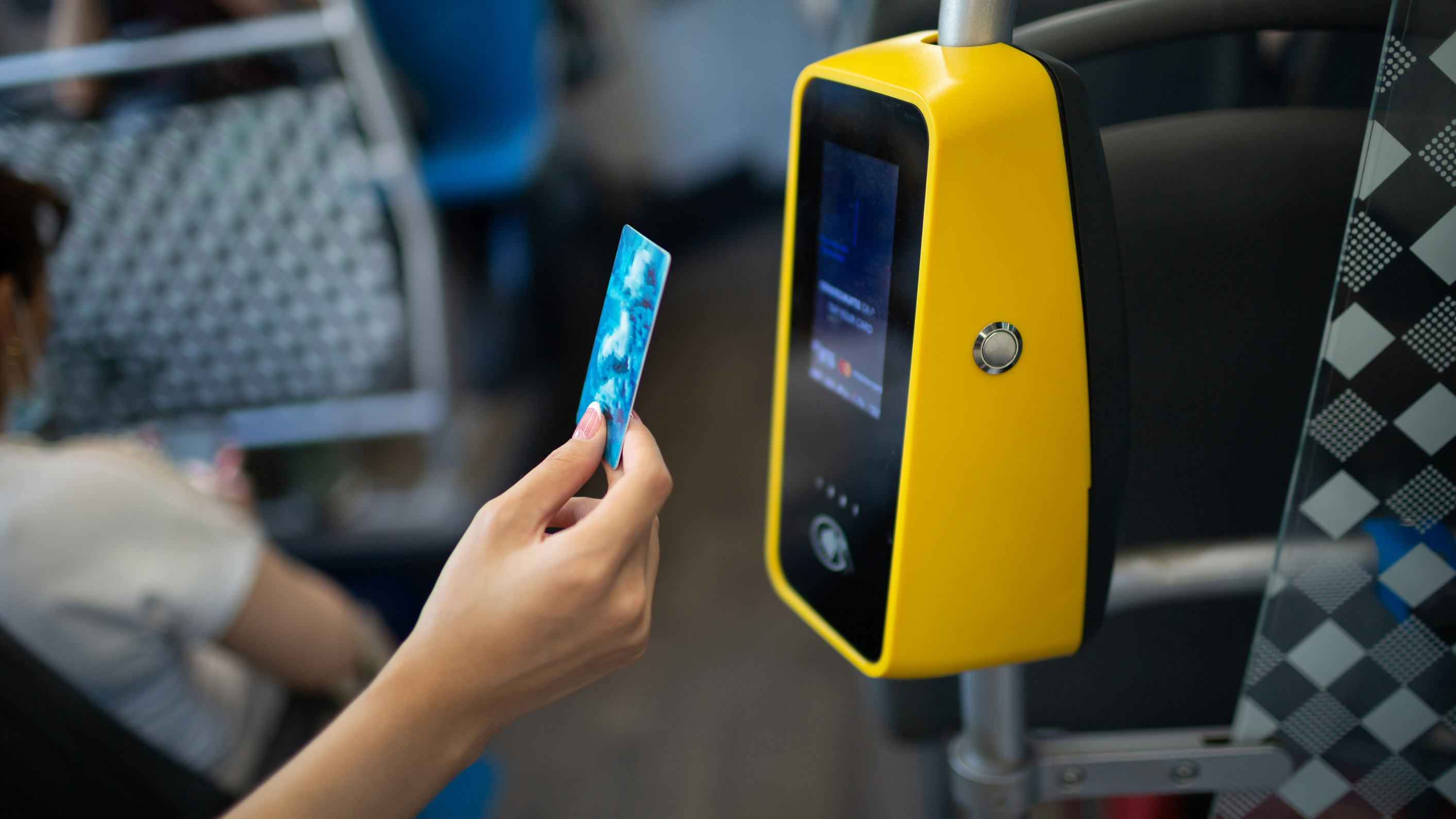Cal-ITP: delivering a frictionless transit experience throughout California and beyond
by Kalin Hitrov

Sustainability, mobility and equity have become touchstones of modern public transit networks across the US – and California has been at the forefront to make travel simpler and more cost-effective for everyone.
In 2019, California’s Department of Transportation launched the California Integrated Travel Project (Cal-ITP) to modernize the transit network. According to Cal-ITP:
“Our goals are not only to improve customer experience, but to increase ridership, lower operational costs, reduce pollution, and ensure everyone can ride transit – no matter their financial situation.”
They’re achieving this by empowering agencies and operators to swap outdated legacy systems and cash reliance for contactless open-loop payments. By demystifying fare structure, making transit more efficient and making networks accessible for passengers of all incomes, contactless EMV payment technology has the power to transform how Californians get around.
Tapping into contactless payments
The linchpin of Cal-ITP is the introduction of contactless payment systems that provide Californian transit agencies with access to global standards for fare transactions, real-time data, and seamless verification of eligibility for transit discounts. By embracing interoperable systems for payment and data sharing Cal-ITP is providing agencies with control over their information and systems and passengers with the convenience they crave – and the benefits are compelling.
Streamlined fare collection
Cal-ITP was created with a firm belief that paying for transit should be as easy as paying for a cup of coffee – by swapping cash for contactless. The first step on its journey to providing passengers with confidence that no matter where they travel, they can instantly pay was the initiation of demonstration projects to implement contactless open-loop fare payments.
This frictionless approach to fare collection uses EMV technology to both pay for and validate travel. EMV is the same tech that allows consumers to pay for goods by tapping the chip in their bank card or a contactless-enabled phone or smart watch. In a public transit setting, EMV allows that card or device to function as a passenger’s ticket. They can pay for and board transport with a single tap, instead of paying for a physical ticket or pre-loading a smart card at a kiosk or vending machine.
Improved operational efficiency
The project’s ability to elevate operational efficiency stems from its focus on enhancing the passenger experience and leveraging data.
By replacing cash with tap-to-pay technology on transit networks in the state, Cal-ITP has made queuing for tickets at kiosks and vending machines a thing of the past. Not only is this expediting boarding times and reducing dwell times; it’s also eradicating costs associated with handling cash and operating legacy ticketing infrastructures.
Cal-ITP is also leveraging the data produced by contactless EMV payments to provide insights into three key metrics – rides, revenue, and riders – that can be harnessed to improve operational efficiency. For instance, data detailing the number of rides per route provides agencies with more specific information that can inform route planning.
Public transit for all
Equity, particularly in terms of affordability, is a core aim of the project. To achieve this, Cal-ITP is working in partnership with payment networks, such as Square/Block, to create bank-like accounts for the nearly 25% of Californians who are currently unbanked. This aims to ensure that the transition from cash to contactless doesn’t leave them behind.
Groundbreaking projects
In 2021, the program successfully initiated four demonstration projects to implement contactless open-loop fare payments across the state, including Monterey, Sacramento, and Santa Barbara.
Monterey
Cal-ITP’s first contactless payment demonstration was launched with Monterey-Salinas Transit (MST), with a focus on equity and a desire to enable as many residents to ride on its fixed-route bus fleet as possible.
MST’s distance-based contactless fares and daily/weekly/monthly contactless fare caps allow passengers to pay as they go until they hit the price of a discounted bulk-ride fare product, simply by tapping on and off a contactless payment acceptance device (PAD).
The agency was the first to offer contactless-enabled automatic benefits for seniors and persons with disabilities. Passengers can verify their eligibility for discounted fares online and instantly add that benefit to a contactless open-loop card or mobile wallet.
In a survey of riders carried out a year after it was launched, the agency found that almost half of all respondents were using the system and found it really convenient. That figure was even higher, at 59%, among Spanish-speaking respondents.
Sacramento
Sacramento Regional Transit (SacRT) worked with Cal-ITP to roll out a contactless payment demo across all its light rail vehicles. The modular system allows SacRT and Cal-ITP to deliver a frictionless solution expeditiously and cost-effectively, removing the need for complex integration with existing legacy closed-loop systems.
Passengers can tap-to-pay for fares using contactless credit, debit, prepaid card or digital wallet. In under a second, a green check mark indicates that their card has been validated for fare payment and they can enjoy the ride.
Santa Barbara
Cal-ITP launched two contactless payment demonstrations in Santa Barbara concurrently: with the Santa Barbara County Association of Governments (SBCAG) Clean Air Express commuter service; and with Santa Barbara Metropolitan Transit District (MTD), whose buses share stops with the Clean Air Express.
These intersecting demos allow transferring passengers to use the same open-loop debit/credit card or mobile wallet on both networks – with enriching results:
- Instant interoperability
- Touch free payment experience
- Reduced interaction with drivers
- Fare capping that replicates existing fare models
Nine months after launching, SBCAG saw strong growth in contactless payment adoption, which jumped from 1.26% in July 2001 to 12.80% in April 2022.
Cal-ITP: the wider impact
Revolutionizing public transit payments in California is a monumental task. The state is home to more than 300 individual transit providers that operate fare collection, fare discounting, and eligibility verification in silos. This lack of standardization creates barriers for new customers, complicates travel across different systems, and increases expenses for individual providers – a narrow approach that’s mirrored across the country.
Undeterred by the scale of the task, Cal-ITP is aligning transportation payment infrastructures with a 21st-century retail experience, with transformative results across California and beyond:
- Enabling passengers to use more efficient and sustainable modes of travel
- Reducing operating costs for transit agencies
- Empowering agencies with limited resources to procure a bespoke payment solution
- Simultaneously welcoming every single person in the country to a seamless, user-friendly system.
With its vision designed for American transit providers everywhere, Cal-ITP is transforming the transit technology industry beyond the California state border by providing resources and technical assistance to transit providers nationwide.
Cal-ITP assistance for agencies
Cal-ITP’s quest to make paying for a transit ride a frictionless experience is underpinned by the support it provides agencies and operators across key processes and requirements:
GTFS-Realtime data analysis
By leveraging the General Transit Feed Specification (GTFS) – the global standard for publishing transit information – Cal-ITP is providing agencies with insights about riders, revenues and rides that help them remove the guesswork from passengers’ journeys, such as when the next service will arrive.
Automating discount eligibility verification
Cal-ITP introduced ‘Benefits’ – a web application that enables digital eligibility verification and enrolment for transit benefits onto a passenger’s existing contactless card or mobile wallet. This streamlines the process for transit passengers to instantly qualify for and receive discounts.
Mobility data standards
Cal-ITP also initiated and contributed toward a set of GTFS Real-time best practices and the GTFS-Fares 2.0 extension, which enables fares to be visible in any trip-planning application alongside schedules.
Master service agreements
Cal-ITP, in collaboration with the California Department of General Services (DGS), established six Master Service Agreements (MSAs) that can be leveraged by agencies throughout the US. This allows transit providers to purchase the key hardware and software needed to accept contactless payments directly from vendors without further competitive bidding.
Working together for a better future
Collaboration is the bedrock of the project’s success – from transit agencies to payment infrastructure providers. Littlepay has been central to this multidisciplinary reliance. For each modular system, we have provided payment processing and worked with pre-integrated partners to complete a solution with payment readers, payment gateways and acquiring services.
To learn how our cloud-based transit payment infrastructure can make travel simpler and cost-effective for everyone on your network, contact our team today.
Trending Topics

Project Highlights: Washington DC’s record breaking upgrade to accept open loop payments

Nevada County Connects leverages Cal-ITP’s Mobility Marketplace to elevate the payment experience across its bus network

 Insight
Insight
 Knowledge
Knowledge
 News
News



